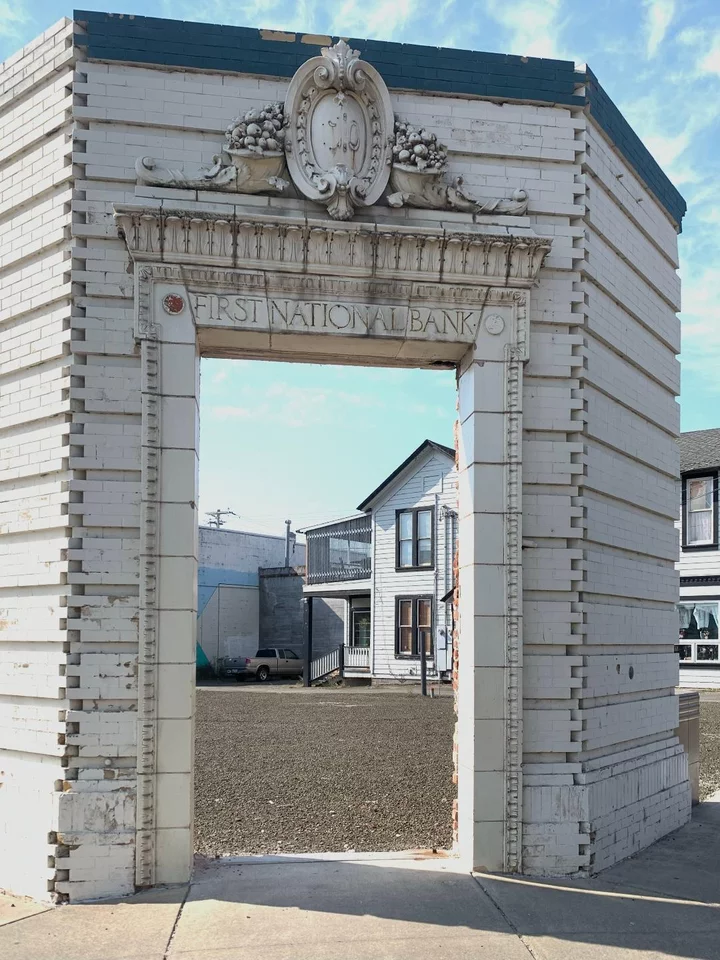On Tuesday December
18, 1928, two armed men disrupted the morning routine of the First
National Bank of Coquille, 20 miles upstream from Bandon, Oregon.
When they failed to gain access — the Vice-President of the bank
slammed the door in their faces — they drove off in a stolen car.
At the edge of town, they abandoned the vehicle and took to the
woods, chased by several townspeople who had been alerted by the
bank’s alarm. A local furniture dealer took aim at one of the
would-be robbers, bringing him down with one shot. Thus ended the
criminal career, and life, of Marion Rube. He was 33.
The scene of Marion Rube’s unsuccessful robbery on the day he died. Coquille’s First National Bank building, built in 1910, was demolished last year. (Unknown photographer)
Rube was a Klamath Native American from the Hoopa Reservation, as was his half-brother, Harrison Smith, a man who served time in San Quentin after a stabbing incident at Martin’s Ferry. After being released, Smith illegally brought whiskey onto the reservation. When confronted by Oscar McCardie, a Hoopa policeman, he was drunk and resisted arrest, and the encounter ended with the policeman shooting Smith dead. That was in February 1915.
Although Smith’s death was ruled justifiable, Indian law demanded that his family be compensated. They refused the $250 offered by McCardie who, from then on, lived in fear for his life, eventually quitting his job and turning to ranching. Six years later, in May 1921, he was shot and killed by Marion Rube, avenging the death of his half-brother as demanded by family honor. Rube was no stranger to firearms; he’d been a sharpshooter in France during World War One. After two trials, both of which ended in a hung jury, Rube was acquitted. Now it was Rube’s turn to compensate McCardie’s family, in accordance with tribal law.
Lacking the necessary funds, Rube determined that banks represented his best hope because, as bank robber Willie Sutton would later explain, “That’s where the money is.” (Apocryphally — a reporter interviewing Sutton in prison actually came up with the phrase.) For his first target, Rube picked the Bank of Fortuna, now the Harland Law Firm on Main Street. It was an unfortunate choice. In a sequence worthy of the Mack Sennett’s Keystone Cops, he and his prizefighter accomplice did indeed rob the bank, but they failed to get away cleanly. They got as far as Carlotta, with a posse of cars in hot pursuit (is there any other type of pursuit?). There, the Oldsmobile which they’d stolen four days earlier quit on them, its wheel bearings burned out after a high-speed chase.
Both men were subsequently captured, Rube meanwhile having stashed his share of the take, $16,000, “at three different locations on the mountain within a half mile of downtown Pepperwood.” according to his then-wife Alice, interviewed in 1988 at age 92. According to one story, the money was never found; another version has Alice driving an expensive new car (a Stutz-Bearcat, for aficionados) soon after the robbery.
In a nod to history, the entrance of the National Bank of Coquille remains as a token shrine to old building. (Barry Evans)
After spending seven years in San Quentin, Rube escaped, three times in the same week, the third time successfully. The story only gets weirder from here. After two months on the lam, Rube shot dead a rancher that he’d mistaken for one of the deputies looking for him. Two months later, he and a partner made their unsuccessful attempt to rob the National Bank of Coquille: see above. According to Jerry Rohde, who records the saga in detail in his book Both Sides of the Bluff, Marion Rube promised he’d never be taken alive. He got his wish.


CLICK TO MANAGE